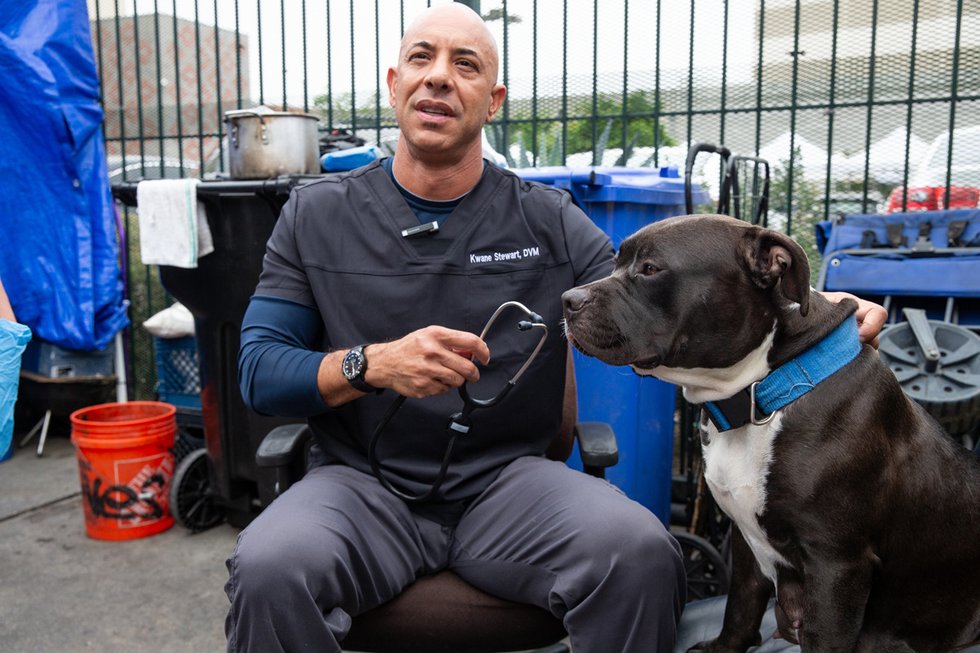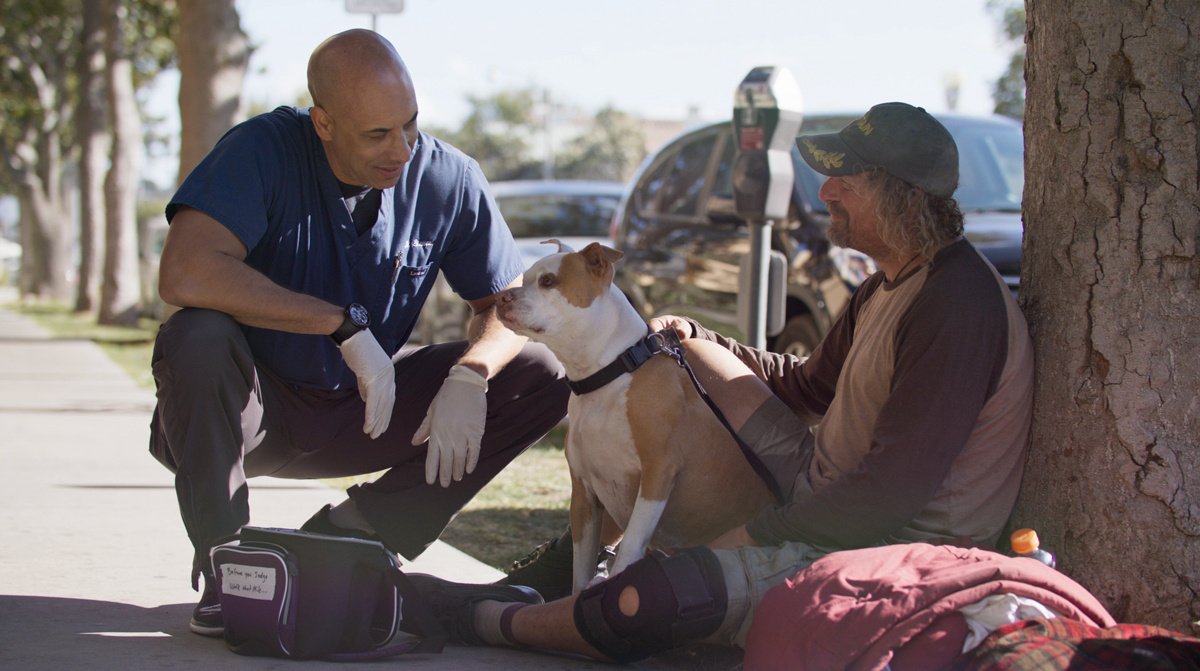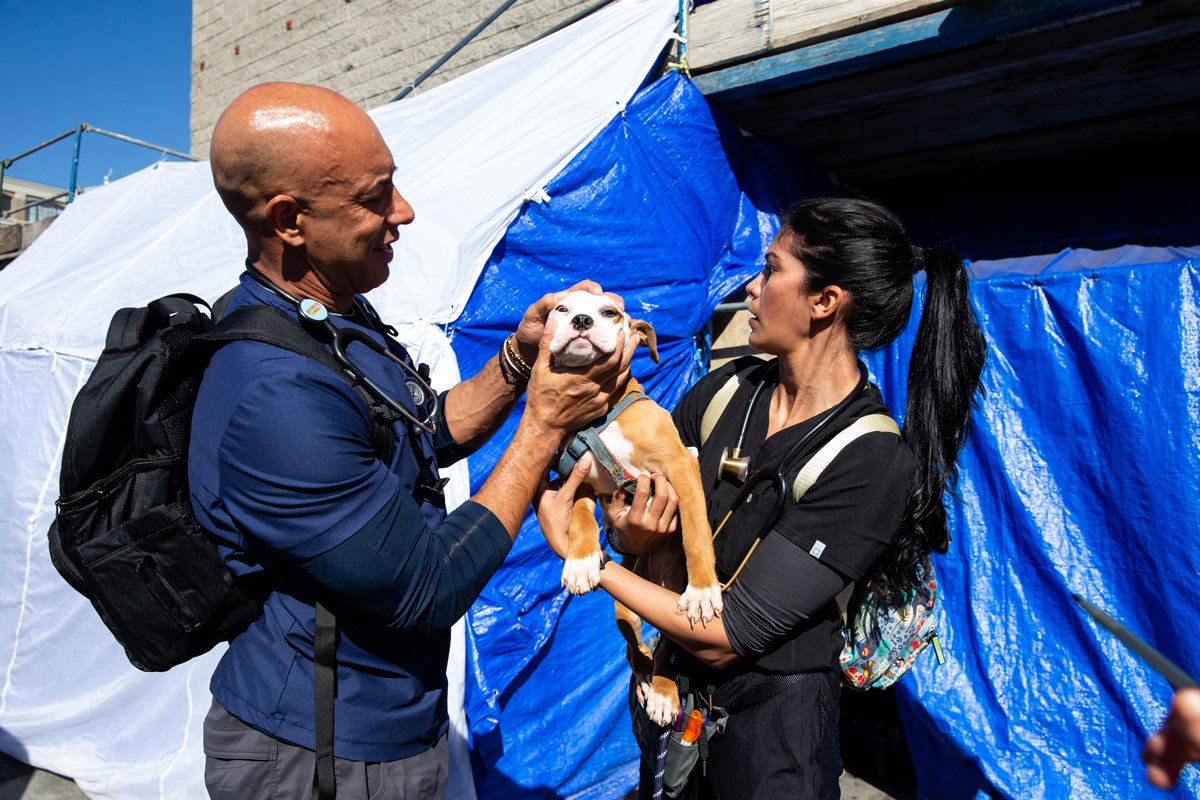Project Street Vet: Caring for the unseen paws of Skid Row
29. 8. 2023
8 min.


Senior Editor at Welcome to the Jungle
The somber reality of Los Angeles’ Skid Row casts a poignant shadow over the city’s renowned opulence. Here, amid the tents and carts that line the streets, a lone dog searches for scraps. Beside him stands his owner, one of 582,000 homeless individuals in the US. Once again he forsakes his own meal, recognizing that the devotion of a loyal pet eclipses his own pangs of hunger. In a country where pets have been cherished companions for over 12,000 years, what happens when the home they embrace is a mere tent or sleeping bag on the cold, unfeeling pavement?
For the 25% of homeless people owning pets, the cost of proper care far exceeds their means. When the health of their animals takes a hit, they have nowhere to turn. Dr. Kwane Stewart, a California-native veterinarian, has dedicated his professional life to helping animals. Now, he’s taking that mission to some of the roughest streets of California.
A founder’s story: Dr. Kwane Stewart
Stewart started his career as a veterinarian 25 years ago, in Southern California. During a five-year tenure as a shelter vet in a struggling area of the city, Stewart became aware of a specific population of pets that weren’t receiving help. “It was usually the underserved or low-economic folk or people just not in a home at all,” he says. “Their pets just weren’t receiving the care they needed because, unfortunately, the pet parents didn’t have the resources.”
At that moment, 12 years ago, an idea sprouted in Stewart’s mind: What if he was the one to provide medical care for these animals?
Project Street Vet: A mission to help the helpless
“The mission is simple,” Stewart says. “We provide free medical care to anybody experiencing homelessness who owns a pet.” In the form of street clinics and spontaneous check-ins with homeless communities, Project Street Vet provides direct vet-to-pet services. There’s no sign-up sheet, no registration process, no payments. Stewart and his team actively seek out the people and pets that need their care and provide it to them.
Due to the high levels of homelessness in California, a lot of the team’s work is focused in cities like Los Angeles and San Diego. However, the organization hopes to expand its teams into other cities across the country to help even more animals and pet owners.
There are 4,400 people experiencing homelessness on Skid Row—a shockingly large number, especially considering the area covers only four square miles.
A day in the life of a street vet
As far as routine goes, Stewart explains that a lot of what goes on in his work is unpredictable. “The coolest part about the job is that there’s a lot of uncertainty and spontaneity and surprises,” he shares. This sense of unpredictability drives him, as he admits to liking not knowing what’s coming next.
In a given week, Stewart allocates a certain amount of time to street work. He’ll pack a kit of treatments, vaccines, and other necessities, park in a dense area of unhoused people, and just start walking. Thanks to his many years of experience, he knows what conditions he’s most likely to encounter. “That’s allowed me to pack a fairly small bag that treats nearly all of the cases that I see on the street. So out of that little backpack, I can treat about 80% of the cases I see on the streets,” he explains. A lot of the care he provides is through vaccinations and prevention treatments.
As for the cases he can’t treat on the spot, they are typically redirected to a veterinary hospital. But that can be expensive, and a burden no one experiencing homelessness wants to carry. To make sure the pet owners are never put under financial stress, the Project Street Vet team steps up. “We will arrange for that person and pet to go to the nearest veterinary clinic and get the care they need. Sometimes it’s an anesthetic procedure, sometimes it’s a dental extraction, sometimes it’s a tumor removal. But these are bigger things that have to happen inside the clinic setting. And the charity covers all those costs,” Stewart shares.
The reality of working on Skid Row
While Stewart’s work isn’t limited to Skid Row, it is an area he works in often. According to the 2022 Greater Los Angeles Homeless Count, there are 4,400 people experiencing homelessness on Skid Row—a shockingly large number, especially considering the area covers only four square miles. Unfortunately, this area is known for drug, crime, and gang activity, with violent crime in Skid Row surpassing the national average by 137%.
The one rule Stewart maintains for himself when working on Skid Row is that he doesn’t go out after dark. Thankfully, he hasn’t experienced any dangerous situations while working in these streets. He believes this is partly thanks to the community starting to know who he is, and the people he has helped standing up for him. “I wear scrubs with my name on them, and I think when people see who I am and believe I am who I say I am, a lot of potentially dangerous scenarios probably go away,” he shares. “They know I’m there for good.”
Cray Cray’s story
If you own a pet, you know what the bond between animal and human is like. From the moment that little creature crawls into your life, there’s a connection. In Stewart’s experience, not even the toughest of situations can break that. “There was this man here in my own hometown of San Diego who had colon cancer,” he shares. “Meanwhile, his little dog, Crazy Girl—he called her Cray Cray—was actually blind when I came across them. She was able to follow him by the sound of his cart, almost like she was on a leash. He sat there as he was telling me the story with tears in his eyes, he looked at me and said, ‘I would gladly keep my cancer, Doc, if you could find a way to get her vision back.’”
The connection between the man and his dog was so strong that he was willing to sacrifice his own health for the well-being of his pet. “That little dog was everything to him,” Stewart recalls. This story is just one of hundreds that Stewart has seen in his work. And witnessing such emotional situations can take a toll on one’s own mental health.
“I think, when we see a homeless person, we want to write their story for them … And it’s not that simple.”
The woes of working in care
At the heart of Stewart’s work lies compassion. Through working with people experiencing homelessness, he has learned that the existing narrative is a false one. “These are human beings. These are people. And the judgment we tend to cast on them is unfair,” he shares. “I think, when we see a homeless person, we want to write their story for them. Why didn’t she get a job, or why are you in this position, or you should have made better decisions. And it’s not that simple. Some of these people just didn’t have a proper upbringing. They didn’t have parental support or didn’t have parents at all. They were in foster care and in tough times during their lives. We’ve all had them. They’ve had nobody to fall back on. That couch you need to sleep on and things get rough—they haven’t had that. So where do they go? What else do they have?”
It’s a sentiment that resonates deeply with Stewart. His commitment to his work goes beyond the care of animals alone. “I want to speak out for the people as much as the pets,” he emphasizes. In this world, he understands that compassion isn’t limited to one or the other. The intertwining of human and animal suffering creates a complex fabric that requires empathy, understanding, and relentless dedication. While passion and empathy drive Dr. Stewart and his team, these same qualities can also take a toll.
Compassion fatigue
When working in any area of care, there is a certain amount of your job that comes home with you. It’s a natural occurrence and one that’s strongly present in the veterinary world. A term that comes up often for these workers is compassion fatigue. This is when care workers take on the suffering of their patients. Stewart admits, “When I started doing this work in 1997 as a fresh out of school, I had no idea what that was.” However, now it’s something he and his team are very aware of.
In their work, Stewart and the Project Street Vet team meet with so many individuals with heartbreaking stories, that it would be impossible for the emotional burden not to affect them. “It’s all heavy,” he says. “You have to imagine if you were in desperate need of something or something that you love was in desperate need of something, and somebody just drops from the sky or comes around a corner and finds you, giving you help and giving you aid. There’s this transfer of emotion and gratitude that you just rarely experience in ordinary life.”
Work-life balance
In Stewart’s experience, developing a healthy work-life balance in this field isn’t always easy. The goals he had as a kid of becoming a vet were not immediately achieved just because he graduated from school—he had to work his way up, and sometimes that meant sacrificing his personal life. “You rarely say no to anybody, you work long hours, and then one day you wake up and you hit a wall, and you aren’t exactly sure why,” he shares. “It took me a lot of years to develop my own self-care to manage this work and personal life. This whole work-life balance we talk a lot about now—that concept didn’t really exist so much 20, 25 years ago.”
According to the National Library of Medicine, the rate of suicide in veterinary professionals has been pegged as close to twice that of dental professionals, more than twice that of medical professionals, and four times the rate of the general population. “We need to pay attention to our mental health,” Stewart insists. If he could share advice with young and future veterinarians, is to learn how to say no. “It’s so hard. I think because by nature we’re wired a little more emotional than everybody else, we have this compassion for animals, this empathy for living creatures, we want to help. We want to people-please. And it’s hard for us just to say no,” he shares. But learning how to set boundaries at work and protect your mental well-being is paramount. “If you want to stay in this game for a long time, as long as I have or longer, you have to pay attention to those things.”
Awareness and amplification through social media
The stories he hears and the people he meets through his work with Project Street Vet can be seen in a variety of videos and posts on Stewart’s social media. With the help of his brother, a business graduate and social media expert, Stewart’s accounts have hundreds of thousands of followers.
On TikTok, Stewart’s videos have millions of views and likes—4.5 million likes, to be exact. But it’s not just virtual validation the project picks up. Stewart shares that the success seen on social media has driven real results for the organization: “A large part of our engagements are donations.” By getting the word out about the work they do, Dr. Stewart and his team are providing a platform for those without one; an opportunity to help.
The road ahead: What’s next for Project Street Vet?
With all the attention the organization has been receiving online, there are many concrete projects forming to help the cause, including a documentary on PBS. Additionally, Stewart shares his plans for an exciting new initiative he plans to implement in the coming weeks. “I’ve been giving medical care for all these years, but I’ve never really addressed the nutritional side. What I found when I’m out in the streets is [that], so often these people will give up their own meal to feed their pets. They’ll be standing in line at a food kitchen and they’ll walk away with a burrito. They’ll give their dog half their burrito,” he shares.
To try to remedy this, Stewart’s next project is a community pet food shed. “I built what I’m calling a dog food pantry, and I’m going to stick the first one up at Skid Row next week,” he says. “It’s basically a small shed that will allow 24/7 access to [pet] food to the residents of Skid Row.” He explains that if the initiative is successful, he and his team will work on implementing the same thing across California, and eventually throughout the country.
Photos: Project Street Vet
Follow Welcome to the Jungle on Facebook, LinkedIn, and Instagram, and subscribe to our newsletter to get our latest articles every day!

Viac inšpirácie: Inšpiratívne príbehy

Be real, get ahead: The power of authenticity in your career
Pabel Martinez shares insights on how to allow yourself to be yourself, find your voice, and deconstruct stereotypes at work.
25. 4. 2024

The professionalism paradox: Navigating bias and authenticity with Pabel Martinez
Pabel Martinez challenges the conventional norms of professionalism by unraveling the complexities of workplace discrimination.
11. 3. 2024

How play can make you happy, creative and productive at work
Work-life balance usually means separating work and play, but it might be a better marriage than you think...
07. 11. 2023

Girls learn how to have fun – and funds – by investing
A Danish trio is fighting gender inequality... on the stock market. We had a chat with one of the co-authors of the book Girls Just wanna Have Funds
30. 1. 2023

A conversation with Ted Conover, master of immersive journalism
We spoke to America’s reigning master of immersion reporting about political polarization, social media and how to hack it as a writer today
26. 1. 2023
Novinky, ktoré to vyriešia
Chcete držať krok s najnovšími článkami? Dvakrát týždenne môžete do svojej poštovej schránky dostávať zaujímavé príbehy, ponuky na práce a ďalšie tipy.

Hľadáte svoju ďalšiu pracovnú príležitosť?
Viac ako 200 000 kandidátov našlo prácu s Welcome to the Jungle
Preskúmať pracovné miesta



